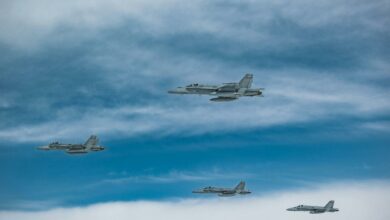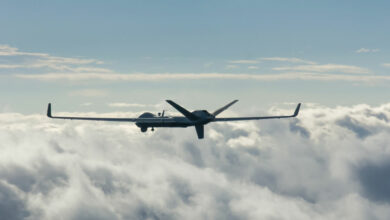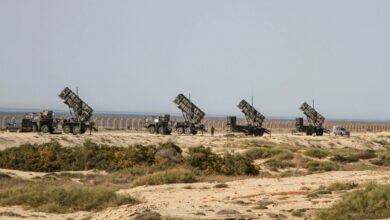
By Danny Anderson
It has often been said that Israel lives in a troubled neighborhood. Multiple regional wars and violent conflagrations with at least half a dozen regional states and armed groups certainly depict a country ill at ease with its neighbors.
Yet the most persistent military challenge in Israel’s 71-year-history has been neither a neighboring enemy nor a regional foe. Israel’s adversaries have come and gone, but one thing has remained consistent: almost every major military campaign that Israel has fought has featured enemy anti-aircraft missile systems.
Since 1948, the Israeli Air Force has been instrumental in Israel’s defense, whether in winning wars, deterring adversaries or keeping enemies at bay. The IAF has conducted air offensives from the Sinai in Egypt in the 1960s and Lebanon’s Bekaa Valley in the 1980s to hundreds of airstrikes on Iran-linked targets in Syria in recent years.
But the IAF’s ability to tilt the scales of battle in all of these theaters has depended on achieving air superiority by circumventing enemy air defences through deception or destruction. When it has failed, victory has been far from guaranteed.
Today, in the midst of a shadow war with Iran playing out in Lebanon, Syria and increasingly Iraq, this age-old feud is once again challenging Israel’s strategy of curtailing its foe. An over-reliance on air power could not only goad Israel into riskier unilateral military action, but even unwittingly afford the proxies of its newest regional adversary with the protection of its oldest military challenge.
A historic duel
The seeds of a longstanding rivalry with enemy air defenses were planted in 1967 when Israel’s decisive victory over Egypt in the Six Day War owed everything to the IAF. A sophisticated electronic warfare attack tricked the displays of Egypt’s Soviet-supplied anti-aircraft missile batteries, allowing Israeli bombers to decimate Egyptian airfields without prior detection or resistance.
Israel learned during the War of Attrition with Egypt between 1967 and 1970 that it could not always operate with impunity. When Egyptian forces pummelled Israeli positions along the Suez Canal with artillery, Israel retaliated with its state of the art U.S.-made fighter jets. But Egypt’s air defense network, strengthened by the Soviet Union, downed numerous Israeli aircraft and left no alternative for Israel but to sue for an uncomfortable ceasefire.
Defensive missile systems continued to offset Israel’s aerial advantage during the Yom Kippur war in 1973. The Soviets had supplied more surface-to-air missile systems to Syria and Egypt, which established an impenetrable defensive shield by placing them on the west bank of the Suez Canal. The costs for Israel were severe as nearly half of its total aircraft losses occurred in the first three days of the war.
On the Syrian front, the challenge was equally formidable. On the second day of war, Israel resorted to Operation Model 5, hoping to target and destroy the bulk of Syria’s batteries. It managed only to eliminate one battery and incur heavy losses, with nine of IAF airmen captured.
The Yom Kippur war was a watershed moment. Although Israel ultimately won the war, it was clear that the road to victory was protracted and more costly without immediate air superiority. The IAF therefore shifted tactics by substituting aircraft maneuvers and covert commando raids with electronic warfare and stand-off guided missiles to combat defiant air defenses.
The first battlefield test of the new approach came during the First Lebanon War in 1982. The IAF launched an unprecedented offensive to eliminate all nineteen Syrian SAM batteries in Lebanon’s Bekaa Valley. Within two hours, Israel destroyed 15 batteries and 90 enemy aircraft. It was the first time that an air force had ever eliminated a Soviet-supplied air defence network.
Syria: An old feud in a new era
Today Israel conducts a whack-a-mole air campaign chiefly in Syria to prevent Iran from constructing offensive infrastructure and to intercept the transfer of precision missile technology to Iranian proxies. That means Israel’s U.S.-supplied state of the art fighter jets are once again going head to head with Syria’s Soviet-era air defense systems.
Amid a congested airspace controlled by Russia who backs the Assad regime, Israel regularly employs electronic warfare and stand-off missiles to circumvent or destroy the SAMs. Tellingly, the IAF has conducted hundreds of airstrikes with the loss of only one fighter jet.
But Israel’s tactical mastery has not been risk free. In February 2018, a stealth Israeli strike triggered Syrian-operated SAMs to mistakenly shoot down a Russian Il-20 surveillance aircraft, killing 15 Russian airmen. Moscow promptly supplied the regime with its formidable S-300 air defense system, one of the latest generations of Russian SAMs, indicating that its tacit tolerance of Israel’s operations had reached its limit.
A similar trend is now emerging in Iraq, where Israel is suspected of striking Iran-backed militias that enjoy considerable autonomy from Baghdad. Iraqi Prime Minister Adel Abdul Mahdi has blamed Israel for a spate of recent attacks against those groups. The strikes have reportedly prompted the Iraqi government to seek the Russian S-400 air defense system, which could complicate Israel’s freedom of operation.
In Lebanon, too, the IAF is facing new challenges to its aerial supremacy. In October, Hezbollah reportedly fired a Soviet-era anti-aircraft missile at an Israeli drone. While Hezbollah will likely not acquire anytime soon the latest generation of SAMs from Russia, demonstrating its possession of rudimentary weaponry still signals to Israel the risks of operating inside Lebanese airspace as well as the greater lengths Israel will have to go to mitigate them.
Faced with increasingly hostile operating environments, Israel may be goaded to double down on its current strategy and to resort to ever-greater aggression – whether cyber, kinetic or a combination of both. In Syria and Iraq, that could translate into attacks on Iraqi or Syrian armed forces operating SAMs. In Lebanon, further attacks like the one in August could provoke Hezbollah to retaliate through its various means or seek more sophisticated anti-aircraft weaponry from its sponsor Iran. The Lebanese government is also unlikely to look favorably upon more frequent violations of its airspace. In all theaters, the risk of an uncontrollable escalation could be only one airstrike away.
Israel is likely buoyed by its long history of air power, cutting-edge missiles and electronic warfare overcoming enemy air defenses and delivering victory in all-out war. But what is in question today is less the ability of Israel’s cutting edge technology – including its fifth generation F-35 fighter jets that were on full display in drills last week– to overcome enemy air defenses than the blowback caused by doing so.
 Danny Anderson is a foreign affairs writer focusing on geopolitics, diplomacy and conflict. He holds an MA in International Studies & Diplomacy from SOAS, University of London.
Danny Anderson is a foreign affairs writer focusing on geopolitics, diplomacy and conflict. He holds an MA in International Studies & Diplomacy from SOAS, University of London.
All views and opinions expressed in this article are those of the author, and do not necessarily reflect the opinions or positions of The Defense Post.
The Defense Post aims to publish a wide range of high-quality opinion and analysis from a diverse array of people – do you want to send us yours? Click here to submit an Op-Ed.











